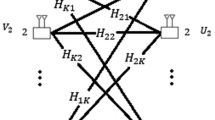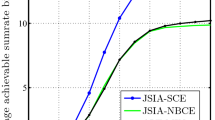Abstract
Interference alignment (IA) with symbol extensions in the quasi-static flat-fading K-user multipleinput multiple-output (MIMO) interference channel (IC) is considered in this paper. In general, long symbol extensions are required to achieve the optimal fractional degrees of freedom (DOF). However, long symbol extensions over orthogonal dimensions produce structured (diagonal or block diagonal) channel matrices from transmitters to receivers. Most of existing approaches are limited in cases where the channels have some special structures, because they align the interference without preserving the dimensionality of the desired signal explicitly. To overcome this common drawback of most existing IA algorithms, two novel iterative algorithms for IA with symbol extensions are proposed. The first algorithm designs transceivers for IA based on the mean square error (MSE) criterion which minimizes the total MSE of the system while preserving the dimensionality of the desired signal. The novel IA algorithm is a constrained optimization problem which can be solved by Lagrangian method. Its convergence is proven as well. Utilizing the reciprocity of alignment, the second algorithm is proposed based on the maximization of the multidimensional case of the generalized Rayleigh Quotient. It maximizes each receiver’s signal to interference plus noise ratio (SINR) while preserving the dimensionality of the desired signal. In simulation results, we show the superiority of the proposed algorithms in terms of four aspects, i.e., average sum rate, the fraction of the interfering signal power in the desired signal subspace, bit error rate (BER) and the relative power of the weakest desired data stream.
Similar content being viewed by others
References
Cadambe V R, Jafar S A. Interference alignment and spatial degrees of freedom for the K User interference channel. IEEE Trans Inf Theory, 2008, 54: 3425–3441
Yetis C, Gou T, Jafar S A, et al. On feasibility of interference alignment in MIMO interference networks. IEEE Trans Signal Process, 2010, 58: 4771–4782
Gomadam K, Cadambe V R, Jafar S A. A distributed numerical approach to interference alignment and application to wireless interference networks. IEEE Trans Inf Theory, 2011, 57: 3309–3322
Peters S W, Heath R W. Interference alignment via alternating minimization. In: IEEE International Conference on Acoustics, Speech and Signal Processing (ICASSP), Taipei, 2009. 2445–2448
Mohapatra P, Nissar K E, Murthy C R. Interference alignment algorithms for the K user constant MIMO interference channel. IEEE Trans Signal Process, 2011, 59: 5499–5508
Papailiopoulos D S, Dimakis A G. Interference alignment as a rank constrained rank minimization. In: IEEE Global Telecommunications Conference (GLOBECOM), Miami, 2010. 1–6
Tiangao G, Jafar S A. Degrees of freedom of the K user MIMO interference channel. IEEE Trans Inf Theory, 2010, 56: 6040–6058
Zhu H L, Wang J Z. Chunk-based resource allocation in OFDMA systems—Part I: chunk allocation. IEEE Trans Commun, 2009, 57: 2734–2744
Zhu H L, Wang J Z. Chunk-based resource allocation in OFDMA systems—Part II: joint chunk, power and bit allocation. IEEE Trans Commun, 2012, 60: 499–509
Steven P W, Heath R W. Cooperative algorithms for MIMO interference channels. IEEE Trans Veh Technol, 2011, 60: 206–218
Prieto R E. A general solution to the maximization of the multidimensional generalized rayleigh quotient used in linear discriminant analysis for signal classification. In: Acoustics, Speech, and Signal Processing (ICASSP), Hong Kong, 2003. 157–160
Zhang X D. Matrix Analysis and Application. BeiJing: Tsinghua University Press, 2004. 103–111
Horn R A, Johnson C R. Matrix Analysis. London: Cambridge University Press, 1990
Gill P E, Murray W. Newton-type methods for unconstrained and linearly constrained optimization. Math Programm, 1974, 28: 311–350
Schnabel R B, Eskow E. A new modified Cholesky factorization. SIAM J Sci Statist Comput, 1990, 11: 1136–1158
Author information
Authors and Affiliations
Corresponding author
Rights and permissions
About this article
Cite this article
Wang, C., Deng, K. Two novel iterative algorithms for interference alignment with symbol extensions in the MIMO interference channel. Sci. China Inf. Sci. 57, 1–14 (2014). https://doi.org/10.1007/s11432-013-4931-5
Received:
Accepted:
Published:
Issue Date:
DOI: https://doi.org/10.1007/s11432-013-4931-5




